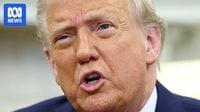As Australia approaches its federal election on May 3, 2025, a confluence of global events and domestic issues is shaping the political landscape. With early voting set to commence on April 22, millions of Australians will soon cast their ballots, determining the direction of the country for the next three years.
This election comes at a time when international relations, particularly with the United States and China, are in a state of flux. Analysts suggest that the Trump administration's current policies aim to isolate China economically, creating a complex backdrop for the election. The recently concluded meeting between U.S. President Donald Trump and Italian Prime Minister Giorgia Meloni at the White House exemplifies this. Trump confidently declared that there would "100 per cent" be a trade deal with the European Union, while Meloni expressed her ambition to "make the West great again — and I think together we can do it." This sentiment reflects a broader struggle among major economies for influence and trade, particularly with the EU, which has shifted its narrative from vulnerability to fostering mutually beneficial ties with both the U.S. and China.
As the election nears, a special pre-election Lowy Institute Poll reveals a troubling trend: trust in the United States has plummeted to a 20-year low, with only 36 percent of Australians expressing confidence in the U.S. to act responsibly. Despite this, a significant 80 percent still view the U.S. alliance as crucial for Australia's security, indicating a complex relationship fraught with ambivalence.
The Australian election campaign has largely focused on domestic issues, with parties debating modest tax cuts and rebates, as well as minor adjustments to fuel prices. However, the global context—marked by the upheaval of the post-World War II order—has been largely sidelined. While cost of living concerns resonate deeply with voters, the candidates have struggled to address the broader implications of international tensions and their potential impact on Australia's future.
Peter Dutton, the opposition leader, has found himself in a precarious position regarding his past enthusiasm for Trump. Initially praising Trump as a "big thinker," Dutton has since distanced himself from the U.S. president's controversial policies as Trump's popularity wanes. In a recent debate, Dutton insisted he did not know Trump well but still claimed he could negotiate better trade deals, a statement that has raised eyebrows given the current political climate.
In a podcast interview, the Prime Minister hinted at the need for Australia to reassess its position in light of the U.S. retreat from its traditional global role, particularly regarding foreign aid and climate policy. This acknowledgment of changing dynamics suggests that the next government will face significant decisions about Australia’s geopolitical future, especially as military experts call for a reevaluation of defense strategies amidst a deteriorating security environment.
Voters will be tasked with electing 150 members of parliament in the House of Representatives and 40 out of 76 senators in the upper house. The voting process in Australia involves ranking candidates on two separate ballot papers—green for the House and white for the Senate. This preferential voting system allows for multiple counts, where votes can be transferred to subsequent preferences if a candidate is eliminated.
This complexity can be daunting for voters unfamiliar with the system. The Australian Electoral Commission (AEC) emphasizes the importance of correctly filling out ballot papers, as improper markings can lead to votes being set aside. In the Senate, voters can choose to vote 'above the line' for parties or 'below the line' for individual candidates, adding another layer of strategy to the process.
Preference deals, though historically significant, are less influential under the current voting reforms, which ensure that voters retain control over their preferences. Political parties can suggest how they would like voters to rank candidates, but the ultimate decision lies with the electorate.
As the election date draws closer, the candidates' positions on pressing issues such as cost of living, climate change, and foreign policy will be scrutinized. The leaders have generally maintained similar rhetoric about standing up for Australian interests while navigating the complexities of their relationship with the Trump administration. However, the lack of detailed policy discussions on how to address global challenges has left many voters feeling uncertain about the future.
The upcoming election is not just about choosing representatives; it is about shaping Australia’s stance in a rapidly changing world. With the potential for two competing global trade blocs emerging—one centered around the U.S. and the other around China—Australia's choice could have far-reaching implications. As Hugh White, a strategic analyst, has noted, the nation may soon have to choose between its key strategic partner, the U.S., and its major trading partner, China. This dilemma underscores the need for a nuanced understanding of the geopolitical landscape as voters head to the polls.
Ultimately, the outcome of the May 3 election will set the course for Australia's future, influencing everything from foreign policy to domestic welfare. As the electorate prepares to vote, they must consider not only the immediate implications of their choices but also the long-term effects on the nation's position in an increasingly complex global arena.






